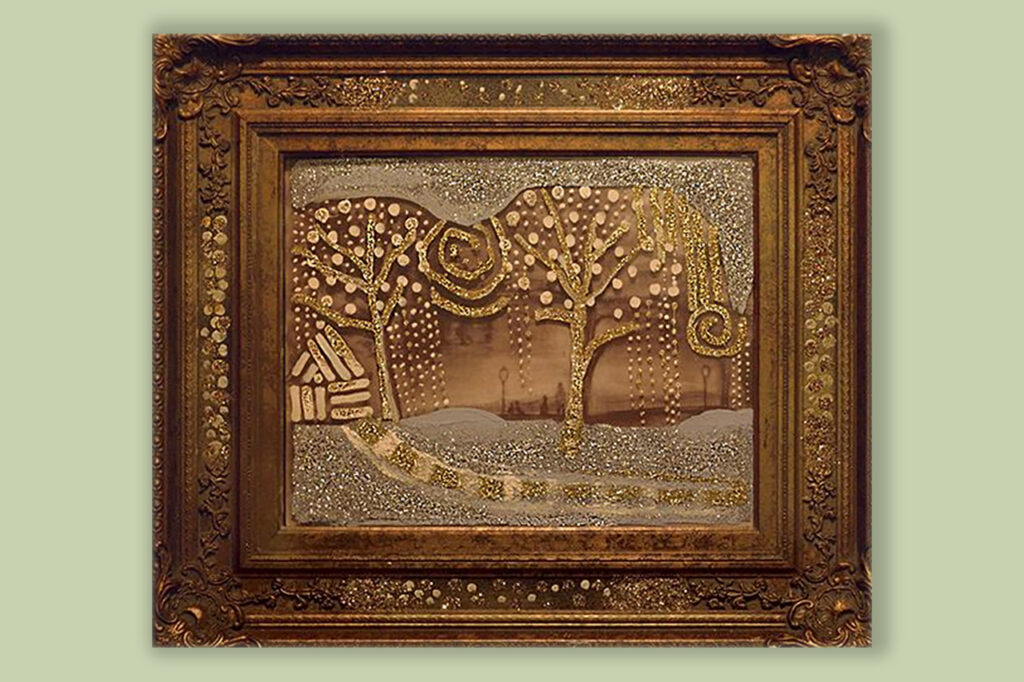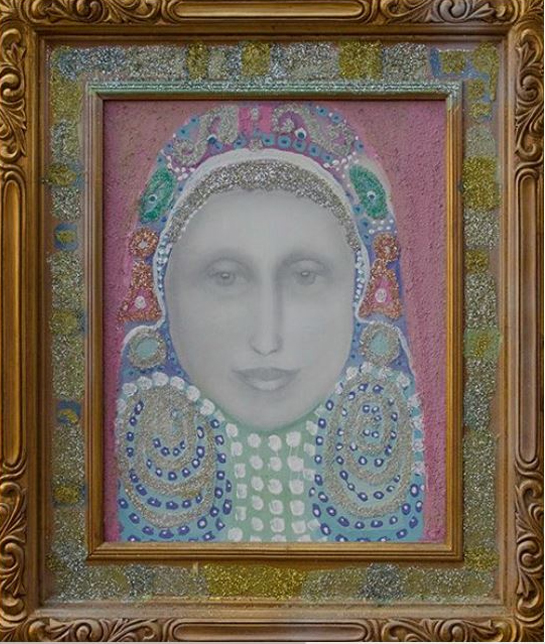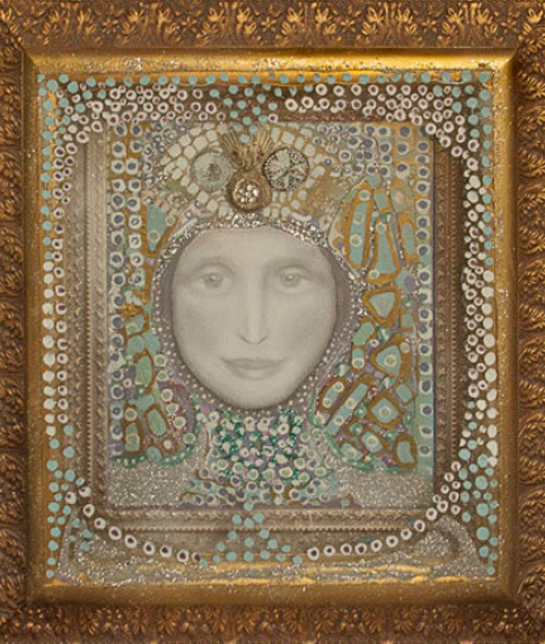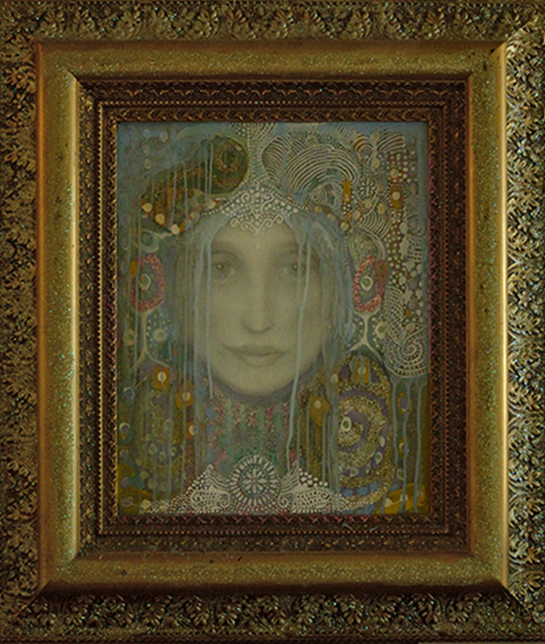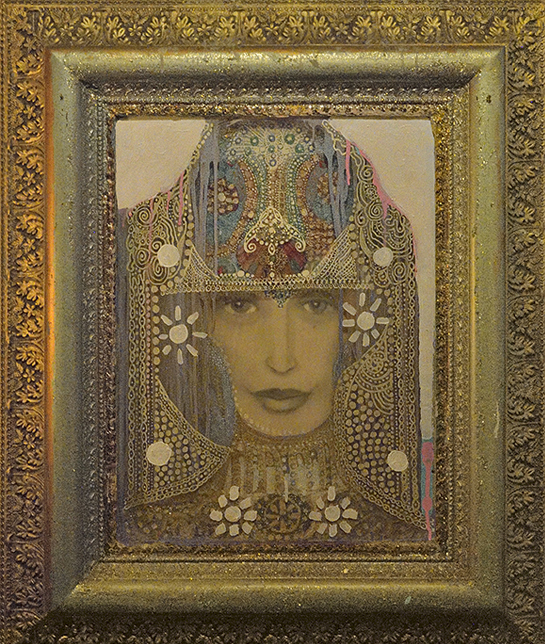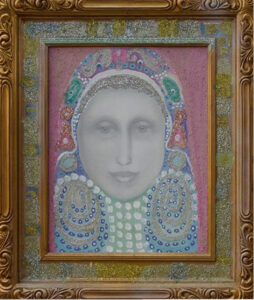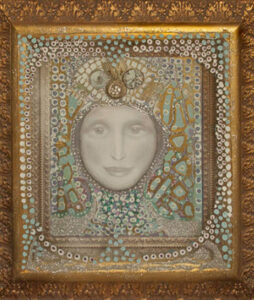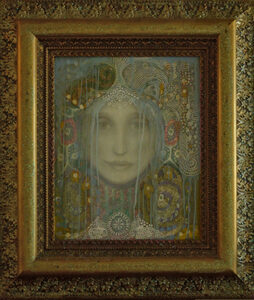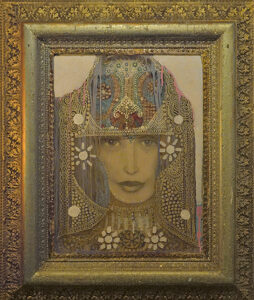
To be an artist in New York / Essere artista a New York
by/di Simona Maria Frigerio (Translation into Italian at the bottom of the page)
art director/direttore artistico Lucia Mazzilli
Art critic, journalist and female artist in New York, Pamela Goldman is also our correspondent from the Big Apple. Knowing and appreciating her work, we have decided to ask her about her paintings, her life philosophy and the US art world in the age of Covid. These are her replies.
Let’s start with your job as an artist. What inspires you to create?
Pamela Goldman: «I’ve always been creative but my particular style started to develop after a trip to The British Museum. I saw a famous work by Leonardo da Vinci which was ‘unfinished’. When you looked at the very large scale canvas, you could see all the various layers of work including the drawings, washes of sfumato paint and his technique came through. What struck me the most was how significant his process was and the virtue in all the dimensions of the piece. I learned to leave the ‘bones’ of my artworks visible by letting the drawings remain intact, visible to the viewer, while embellishing around it. I believe the integrity of the piece always begins with the drawing and for hundreds of years, artists painted over this on purpose so that their work would appear ‘finished’”.
What is your technique?
P. G.: «It’s a practice of layering inspired by my mentor and husband, Gerald S Feldman. On one layer is the canvas and drawings well as some surrounding painting, but nothing exists to hide the integrity of the drawing. Then I put a piece of plexi-glass on top and continue to embellish that with paint, ink and so forth. This effect gives my painting depth and protects my drawings at the same time. Mistakes are unavoidable but nothing can harm the drawing. I also at times paint designs on the frames and use mixed media on the outer layers such as seashells, and sparkles, bringing more depth to the piece. It’s almost as if I want the soul of the painting to come through which in many cases, exudes a certain peacefulness and wisdom».
Your works almost seem like holy icons; do you intend for that as you create?
P. G.: «I do not intend to create holy icons but if people see them that way, that’s great! I do think there is virtue in their expressions and I’m not in control of this. It is what is downloaded to me by the universe when I draw and paint. Maybe it’s connected to the part of me that is still innocent and untainted by all I have experienced in life».
What is it like being a female artist in NYC?
P. G.: «Two winters ago, before Covid, I had a show in Greenwich Village. It was a retrospective that got 80% sold out. I had to keep replacing the works because people were paying in cash and buying them off the walls to take home. It was at a restaurant/cultural center and the owner, Robin Hirsch, didn’t even take a percentage. All of the proceeds went straight to me which is unheard of these days.The show lasted about a month and because this was pre-COVID, many people were still out and about, drinking, eating and enjoying the city without fear. When COVID struck, the many freedoms people had, shut down. Restaurants and galleries closed their doors, some had to permanently because they did not have the funds to survive the disaster. This occurred in all major art-center cities around the world as well. But getting back to your question about being a female artist….It hasn’t stopped me at all. The glass ceilings for women are being broken every day. It’s hardly an issue for me and my husband is a bit of a feminist as well. We both had tears of joy when Kamala Harris was sworn in as the first female U.S. Vice President».
How is the current situation, socially and economically, in NYC?
P. G.: «In the U.S. since the vaccine has been widely distributed thanks to the efficiency of President Biden and his goals and mandates, there has been an upturn in the economy. New restaurants are swiftly opening as well as galleries. The feeling of being ‘locked down’ is gradually lifting. Wearing masks and disinfecting our hands is still part of our lifestyle. I think the law is that you must still wear a mask when entering any closed venue such as stores, markets, pharmacies and so forth. However, outside, I think it’s okay to take your mask off, although we don’t. The take-out food business has been booming and restaurants can fill their spaces to 75% capacity. They must take the temperature of everyone who enters their establishments as a precaution. Homeschooling is still suggested at least part-time. Museums have reopened but to a much smaller audience capacity. Many workplaces have permanently become virtual… so some things will not return to the way it was. Socially, Covid was either a deal-maker or deal-breaker in relationships and marriages. Domestic violence was on the rise, but I think that has been tapering off. The house-bound stress was simply too much for a large number of marriages to survive. Dating, which had become almost obsolete, is now gaining traction. Personally, for my husband and myself, the Covid situation came into play because our apartment lease was ending. Many people left the city during the height of the pandemic causing the real estate market to drop in price. We were able to find an apartment 4 times as large, on a nicer block for the same amount of money we had been paying. It also has great natural lighting».
What is your advice to young artists who are just starting out?
P. G.: «As Adidas says, “Just do it!” Don’t wait for permission to become an artist. Deep down we are all creative beings. Some are better at accessing that part of themselves than others. However, it’s in everyone’s DNA to create in whatever form comes naturally.Do the work! Nobody can take away your artistic inclinations. Don’t listen to the naysayers who believe only true artists have their work in museums. That is so ridiculous and small-minded. You are entering the dance of life. Do what feels natural and good. You will be happier, live longer and ultimately have a freedom of spirit which is priceless».
Do you have a particular philosophy you want to share?
P. G.: «The act of creation, whether it’s making a piece of art, designing a car or even giving birth to a baby, is a Godly deed. If you don’t believe in God, think of it as a divine or heavenly inspired activity or a gift from the universe. Create from your heart and live with passion. The ancient Greeks asked one question when a person passed. Did he or she live with passion? This is what’s most important. Remove the blockage to what inspires you or turns you on and you won’t regret a day of your life. This the French call, joie de vivre. Having the spirit of joy in a fulfilling life. Even in politics, business, law and so forth, those who are ingenious in their field, are creators of new systems, perspectives and so forth. They think outside the box. We are all unique beings with unique gifts. Find your unique gift and everyday will become a celebration. Your awakening will inspire others as your gifts unfold and life will become magical. This is destiny fulfilled, as it were».
Friday, May 28, 2021
On the cover (and in the article): paintings by Pamela Goldman / courtesy of the artist (all rights reserved).
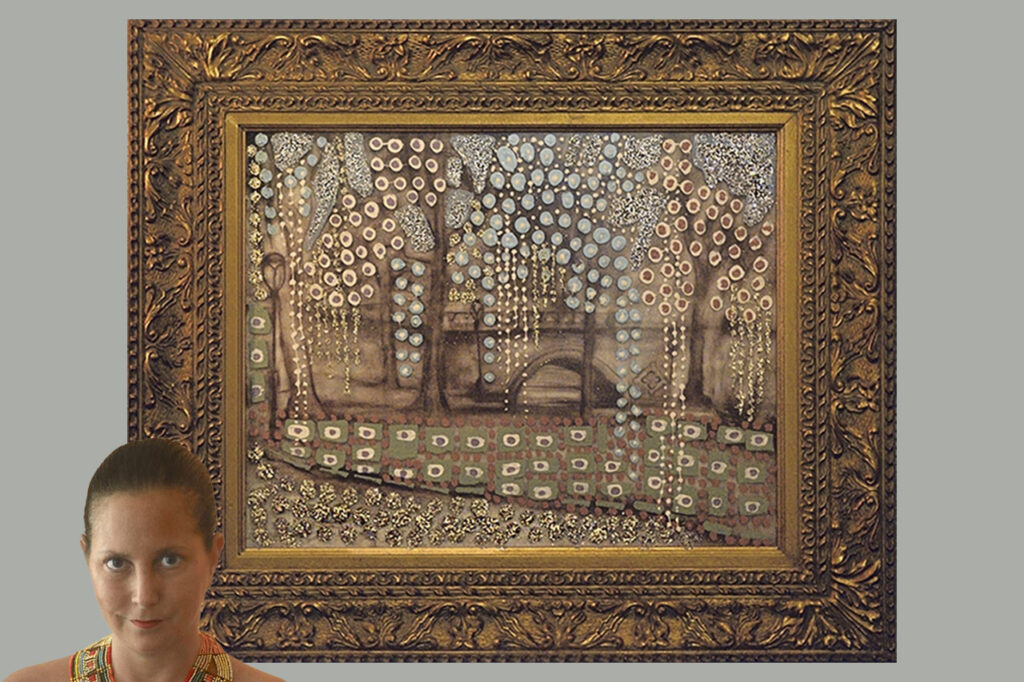
Testo in italiano
Traduzione di Simona Maria Frigerio
Critico d’arte, giornalista, artista donna a New York, Pamela Goldman collabora anche con la nostra redazione dalla Grande Mela. Conoscendo e apprezzando il suo lavoro, abbiamo deciso di chiederle qualcosa di più sui suoi quadri, la sua peculiare filosofia di vita e la situazione generale degli artisti statunitensi in tempo di pandemia. Queste le sue risposte.
Iniziamo dal suo lavoro di artista. Quali le fonti di ispirazione per la sua creatività?
Pamela Goldman: «Sono sempre stata una persona creativa ma ho iniziato a sviluppare il mio stile dopo una visita al British Museum. Vidi una celebre tela di Leonardo da Vinci che ‘non era finita’. Osservando la tela di grande formato, potevo intravedere i vari strati del lavoro compresi i disegni, gli sfumati leonardeschi e ‘in trasparenza’ la tecnica del Maestro. Ciò che maggiormente mi colpì fu quanto fosse importante il processo e le qualità di ogni stadio dell’opera. Ho appreso a lasciare le ‘ossa’ dei miei lavori artistici ben visibili permettendo al disegno di restare intatto, percepibile dall’osservatore, mentre impreziosisco ciò che gli sta intorno. Credo che l’integrità dell’opera risieda nel disegno e per secoli gli artisti vi hanno dipinto sopra affinché la tela apparisse ‘finita’”.
Quale tecnica usa?
P. G.: «Pratico una stratificazione ispirata da Gerald S. Feldman – mio marito e mentore. Su uno strato vi sono la tela con i disegni e qualche tocco di pittura circostante – ma nulla è inteso a nascondere l’integrità del disegno. Quindi, posiziono al di sopra un pezzo di plexiglass e lo impreziosisco con la pittura, l’inchiostro e via dicendo. Questo effetto dà al dipinto profondità e, contemporaneamente, protegge il disegno. Gli errori sono inevitabili ma nulla può mettere in pericolo il disegno. A volte dipingo anche le cornici e utilizzo la tecnica mista negli strati più superficiali, come conchiglie e brillantini, così da aumentare la profondità dell’opera. È quasi come se volessi che l’anima del dipinto trasparisse – e, in molti casi, emana una sorta di pace e saggezza».
I suoi quadri ricordano le icone sacre: è un suo obiettivo quando crea?
P. G.: «Non intendo creare icone sacre ma se le persone intendono così le mie opere, va benissimo! Penso vi sia virtù nelle espressioni – ma questo risultato non è sotto il mio controllo: è quanto l’universo riversa in me quando disegno e dipingo. Forse è connesso con la parte di me che è tuttora innocente e incontaminata da quanto ho sperimentato nella vita».
Com’è essere un’artista donna a New York City?
P. G.: «Due inverni fa, prima del Covid, ho tenuto una personale al Greenwich Village. Era una retrospettiva e ho venduto l’80% delle opere. Per tutto il tempo ho dovuto rimpiazzare i quadri che i visitatori acquistavano pagando in contanti e staccando le tele dalle pareti per portarsele direttamente a casa. Lo spazio espositivo era un centro culturale/ristorante e il proprietario, Robin Hirsch, non volle nemmeno la percentuale. I guadagni furono interamente miei, il che è raro al giorno d’oggi. L’esposizione è durata circa un mese e, dato che si trattava di un evento prima del Covid, erano molte le persone che rimanevano fuori, bevendo, mangiando e godendosi la città senza timori. Quando è scoppiata la pandemia, le libertà personali sono state azzerate. Ristoranti e gallerie d’arte hanno chiuso, alcuni permanentemente perché non avevano fondi sufficienti per sopravvivere al disastro. Questo è accaduto anche in molte tra le maggiori città d’arte a livello mondiale. Ma tornando alla sua questione, riguardo all’essere donna e artista… Personalmente, non mi ha fermata. ‘I soffitti di cristallo per le donne sono infranti ogni giorno’ [espressione statunitense, coniata nel 1978 da Marilyn Loden, n.d.t.]. Non è un gran problema per me e anche mio marito è un po’ femminista. Abbiamo entrambi pianto di gioia quando Kamala Harris ha giurato come primo Vice presidente donna degli Stati Uniti».
Com’è la situazione, a livello sociale ed economico, a New York City?
P. G.: «Negli Stati Uniti, dato che il vaccino è stato largamente distribuito grazie all’efficienza del Presidente Biden – e i suoi obiettivi e mandato – vi è stata una ripresa economica. Nuovi ristoranti stanno velocemente aprendo così come gallerie d’arte. La sensazione di essere ‘rinchiusi’ sta gradualmente scemando. Indossare la mascherina e disinfettarsi le mani sono ancora parte del nostro stile di vita. Penso la legge obblighi tuttora all’uso della mascherina al chiuso – ossia nei supermercati, mercati, farmacie e così via. In ogni caso, all’aperto, penso vada bene anche non indossarla – anche se noi non lo facciamo. C’è stato un vero boom del take-away e i ristoranti possono riempire i locali al 75% ma devono misurare la temperatura a chiunque entri per precauzione. La Dad è tuttora consigliata, almeno part-time. I musei hanno riaperto ma per un numero più ristretto di visitatori. Molti luoghi di lavoro sono diventati permanentemente virtuali… quindi, alcune cose non torneranno come prima. A livello sociale, il Covid è stato o un affare o un fallimento per quanto riguarda relazioni e matrimoni. La violenza domestica è aumentata, ma adesso credo sia in graduale riduzione. Lo stress per essere costretti in casa è stato troppo per un gran numero di coppie. Il corteggiamento, che era quasi obsoleto, sta riprendendo piede. Personalmente, per mio marito e me, il Covid è esploso quando il nostro contratto d’affitto stava scadendo. Molte persone hanno lasciato la città durante il picco della pandemia causando un crollo dei prezzi di mercato delle abitazioni. Così abbiamo trovato un appartamento quattro volte più spazioso, in un quartiere più carino allo stesso costo del precedente. E ha anche una bella luce naturale».
Ha consigli per gli artisti agli inizi della loro carriera?
P. G.: «Come dice lo slogan, “Just do it!”. Non attendete il permesso per diventare artisti. In fondo siamo tutti esseri dotati di creatività. Alcuni sono più bravi ad avere accesso a quella parte di loro stessi. In ogni caso, è nel DNA di ognuno creare – in qualsiasi forma si senta come naturale. Lavorate! Nessuno può privarvi delle vostre inclinazioni artistiche. Non ascoltate gli scettici che credono che solo i veri artisti espongano nei musei. È una visione ridicola e limitata. State accedendo alla danza della vita. Fate ciò che per voi è naturale e giusto. Sarete più felici, vivrete più a lungo e, in definitiva, la libertà dello spirito non ha prezzo».
Vuole condividere con noi la sua filosofia di vita?
P. G.: «L’atto della creazione, che si tratti di un’opera d’arte, la progettazione di un’auto o far nascere un bambino, è un atto divino. Se non si crede in Dio, si può pensarlo come un’attività ispirata o un dono dell’universo. Create con il cuore e vivete con passione. Gli antichi greci facevano una domanda quando una persona moriva. Lui o lei ha vissuto con passione? Questa è la cosa più importante. Rimuovere i blocchi nei confronti di ciò che è fonte di ispirazione – o sa accenderci – e non rimpiangeremo un solo giorno di vita. Questo è il significato del francese joie de vivre: realizzare la propria esistenza con gioia. Persino a livello politico, legale, negli affari, e così via. Coloro che sono geniali nel loro campo, creano nuovi sistemi e prospettive, pensano fuori dagli schemi. Siamo tutti individui unici con doni altrettanto unici. Bisogna trovare questo nostro dono e ogni giorno diventerà una festa. Il vostro risveglio ispirerà altri, mentre le vostre capacità si svilupperanno e la vita diventerà magica. Questo significa compiere il proprio destino».
Venerdì, 28 maggio 2021
In copertina (e nell’articolo): quadri di Pamela Goldman / gentile concessione dell’artista (tutti i diritti riservati).
